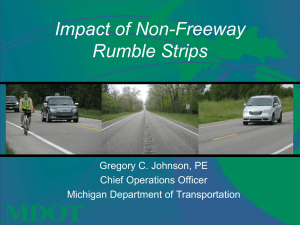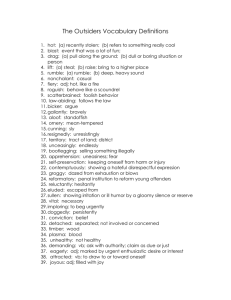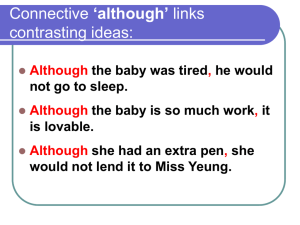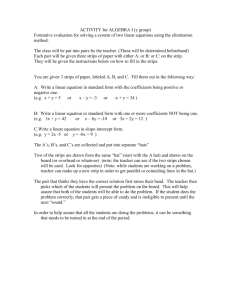2008-50 Long Term Maintenance Effects on HMA Pavements Caused by
advertisement
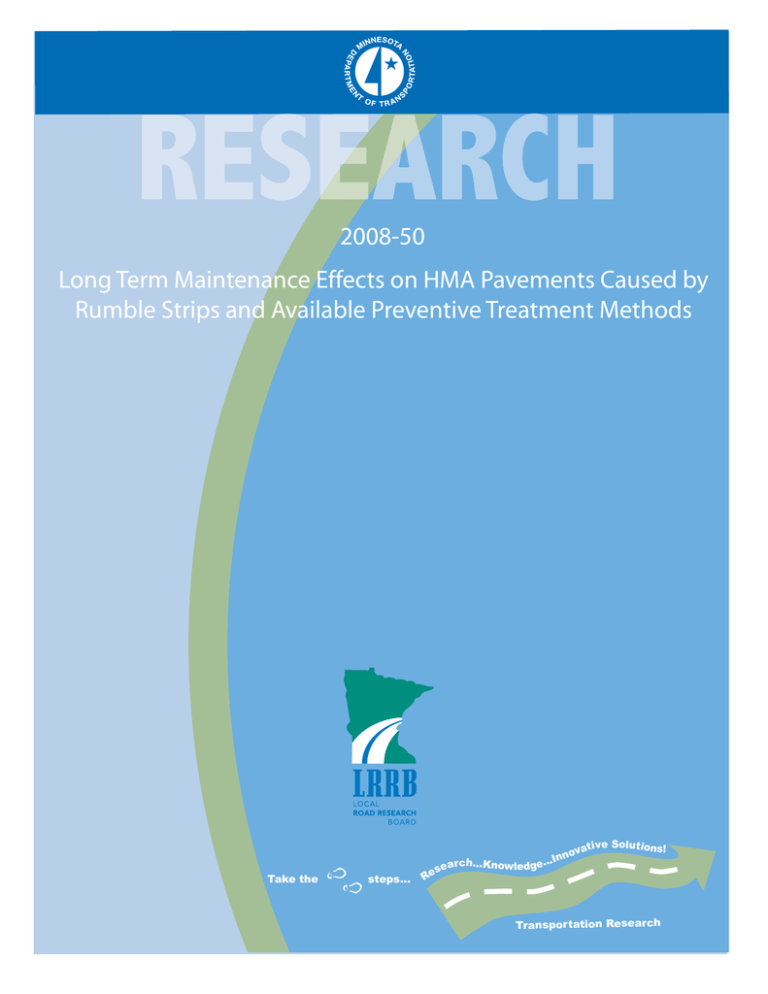
2008-50 Long Term Maintenance Effects on HMA Pavements Caused by Rumble Strips and Available Preventive Treatment Methods Take the steps... ve Solutions! vati nno I . . h . c . . r . K nowledge sea Re Transportation Research Technical Report Documentation Page 1. Report No. 2. 3. Recipients Accession No. MN/RC 2008-50 4. Title and Subtitle 5. Report Date Long Term Maintenance Effects on HMA Pavements Caused by Rumble Strips and Available Preventive Treatment Methods October 2008 7. Author(s) 8. Performing Organization Report No. 6. Mark Watson, Roger Olson, John Pantelis, Eddie Johnson, and Tom Wood 9. Performing Organization Name and Address 10. Project/Task/Work Unit No. Minnesota Department of Transportation Office of Materials 1400 Gervais Avenue Maplewood, MN 55109 INV 841 12. Sponsoring Organization Name and Address 13. Type of Report and Period Covered Minnesota Department of Transportation 395 John Ireland Boulevard St Paul MN 55155 Final Report 11. Contract (C) or Grant (G) No. 14. Sponsoring Agency Code 15. Supplementary Notes http://www.lrrb.org/PDF/200850.pdf 16. Abstract (Limit: 200 words) Rumble strips are a cost effective safety treatment for rural pavements, however they allow water to pool and increase the surface area of the pavement exposed to the elements. This research sought to address the maintenance effects of rumble strips on HMA pavements and what effect, if any, these have on the service life of the pavement. A survey was conducted which found that most respondents either noted the presence of distresses in rumble strips, or were concerned that the rumble strips were the direct cause of distresses. Next this study recommended several treatment options for pavements with rumble strips. Many of these recommendations are anecdotal and based on engineering judgment, which underscores the need for additional research. The recommended preventive maintenance treatment is to use construction funds to apply a cationic rapid set polymer modified diluted (CRS-2pd) fog seal over the entire shoulder, including the rumble strips. This will ensure an initially sealed surface and provide the maximum benefit in terms of service life extension. Crack sealing, although not an integral part of preventive maintenance for rumble strips should be applied to the adjacent cracks to slow the growth of cracks into ground in rumble strips. 17. Document Analysis/Descriptors Rumble strips Crack sealing Asphalt 18. Availability Statement Pavements HMA No restrictions. Document available from: National Technical Information Services, Springfield, Virginia 22161 19. Security Class (this report) 20. Security Class (this page) 21. No. of Pages Unclassified Unclassified 23 22. Price Long Term Maintenance Effects on HMA Pavements Caused by Rumble Strips and Available Preventive Treatment Methods Final Report Prepared by: Mark Watson Roger Olson John Pantelis Eddie Johnson Tom Wood Minnesota Department of Transportation Office of Materials 1400 Gervais Ave. Maplewood, MN 55109 October 2008 Published by: Minnesota Department of Transportation Research Services Section 395 John Ireland Boulevard, MS 330 St. Paul, Minnesota 55155-1899 This report represents the results of research conducted by the authors and does not necessarily represent the views or policies of the Minnesota Department of Transportation. This report does not contain a standard or specified technique. The authors and the Minnesota Department of Transportation do not endorse products or manufacturers. Trade or manufacturers’ names appear herein solely because they are considered essential to this report. Table of Contents Chapter 1. Introduction .............................................................................. 1 Pavement Deterioration ............................................................................................... 1 Rumble Strips - Definitions.......................................................................................... 1 Previous Studies ............................................................................................................ 1 Study Objectives ........................................................................................................... 2 Chapter 2. Methodology & Results............................................................ 3 Minnesota Survey ......................................................................................................... 3 National Survey............................................................................................................. 4 Available Treatments ................................................................................................... 5 Crack Treatments ..................................................................................................... 5 Fog Sealing................................................................................................................. 5 Sealers ........................................................................................................................ 6 Rejuvenators.............................................................................................................. 7 Chapter 3. Conclusions & Recommendations .......................................... 8 Additional Resources.................................................................................. 10 References.................................................................................................... 11 Appendix A – Mn/DOT Specifications ..................................................... 12 Appendix B – Tabulated Survey Results.................................................. 17 i Chapter 1. Introduction Pavement Deterioration Although it has been well documented that rumble strips can assist with alerting a driver of a potentially hazardous situation thus reducing accident rates and improving safety; there is little documentation of the long term effects that rumble strips may have on the deterioration, and subsequent reduction in service life of the asphalt pavement. There has been speculation that installing rumble strips (by cutting or grinding) accelerates the deterioration process due to the geometry of the cuts which allows water to pool, or freeze. Users of TH 23 in Minnesota voiced their concern over the formation of potholes [1], additionally it is not well understood what effect (amount of damage, or ESAL loading) the installation process has on the pavement, especially on older, rural shoulders, which typically are more distressed, and not structurally designed to carry traffic. Rumble Strips - Definitions The Federal Highway Administration (FHWA) defines rumble strips “as raised or grooved patterns on the roadway shoulder that provide both an audible warning (rumbling sound) and a physical vibration to alert drivers that they are leaving the lane.” The FHWA also classifies rumbles strips into three types: • Shoulder rumble strips (SRS): The most common type located on the road shoulder of expressways, interstates, parkways, and two-lane rural roadways • Centerline rumble strips (CRS): Often used on two-lane rural roadways • Transverse rumble strips (TRS): Installed on approaches to intersections, toll plazas, horizontal curves, and work zones. Previous Studies NCHRP Synthesis No. 339 [1] detailed the current state of the practice with regard to the use, design and effects of centerline rumble strips (CRS) by conducting a region wide survey (American States and Canadian Provinces) as well as contacting various international authorities. The researchers also conducted an extensive literature review of both published and unpublished resources. The concern of pavement deterioration caused by rumble strips was not common to those who responded to the 1 survey, which had a 90% response rate, only Alaska and Oregon reported pavement deterioration problems, or concerns. The researchers noted that although there is no clear evidence, grinding rumble strips into the pavements’ centerline may accelerate the deterioration of the longitudinal cold joint [1]. Outcalt [2] published the results of Colorado’s four year evaluation study of CRS, in which he noted that there was no noticeable effect on the pavement due to moisture, and only slight deterioration of the paint stripe. Elefteriadou et al [3] published Pennsylvania’s research into rumble strips including the potential effects of rumble strips on the pavement performance summarized below: • Rumble strips can lower the effective structural cross-section of the pavement, especially for thinner pavements on low volume roads. • Rumble strips may allow greater moisture infiltration and consequently increase the stripping potential of the bituminous mix. • Centerline rumble strips installed in the crown of the roadway may hinder drainage Price [4] published the use of chips seals over rumble strips in Colorado. The two main safety benefits (rumble and visual effects) were supplemented by the repair benefit. Although this is not a true preventive maintenance application of the treatment, the chip seal was reported to act as a temporary fix to a badly deteriorated shoulder Study Objectives This report will detail the methodology used to determine whether or not the presence of rumble strips contributes to the deterioration of asphalt pavements, and what preventive maintenance options are currently available to treat the distress and limit the degradation process. 2 Chapter 2. Methodology & Results The primary methodology employed in this study to determine the effects of rumble strips on HMA pavements, and the treatments employed, involved sending out a survey to various local and state agencies. Minnesota Survey The survey that was sent to all 87 Minnesota counties and 8 Mn/DOT Districts consisted of the following questions: 1. What type and how many miles of rumble strips are present? 2. Are distresses present in the rumble strips? 3. What treatments have been taken to reduce, eliminate, or fix the distresses? The responses of this survey, along with the survey itself can be found in appendix A, a summary of the state and county results is depicted in Table 2.1 below. Table 2.1. Summary of Minnesota County and Mn/DOT District Survey Results Does your agency have rumble strips? What Type of Rumble Strips are used? Distresses Present in Rumble Strips Yes No No Response Shoulder Centerline Stop Bar (Transverse) Yes No Mn Counties (%) 54 27 19 14 0 79 100 0 Mn/DOT Districts (%) 75 0 25 100 75 100 67 33 Twenty-six Minnesota Counties responded to this survey, for a response rate of 29.9%. Of these 26 Counties responding, 54% reported that their County uses rumble strips of some type. 27% of respondents reported they had not utilized any type of rumble strips, and 19% gave no response. Stop Bar rumble strips were used by 78% of respondents, while Shoulder rumble strips where reported by 14% of respondents. No County reported any Centerline rumble strips. 100% of the respondents who had shoulder rumble strips indicated that there were distresses in these rumble strips. The counties also reported that ground in rumble strips seemed to have a higher chance of causing distress to the underlying HMA. 3 Four out of eight Mn/DOT districts responded to this survey. Of these four respondents, three reported using “hundreds and hundreds of miles” of SRS and CRS. Two of the four Respondents reported that distresses where apparent in their HMA sections. Comments from the counties and Mn/DOT districts ranged from utilizing Stop Bar rumble strips (TRS) only, to continued maintenance activities are needed, and continued retro reflectivity from fog sealed sections. Some stated that rumble strips need to be quieter, while other notable statements included: “The rumble strips can cause distresses in the pavement; typically the road fails due to deterioration of the thermal cracks, primarily transverse.” National Survey The survey sent to the state transportation agencies was shorter in an attempt to improve the response rate. The abbreviated state survey consisted of the following questions: 1. Are either centerline, or shoulder rumble strips used? 2. Have you observed any deterioration in the HMA pavement caused by the Rumble Strips? 3. Have treatments been employed to reduce, or eliminate damage from the placement of rumble strips? The results of this survey are summarized in Table 2.2, note that these results are not directly comparable to the results obtained in Minnesota because of the wording of the second and third questions. Of the 26 States that responded, 24 reported using rumble strips. Some general comments from these states are summarized below: • Many States are only a few years into high Rumble Strip use • Ground in rumble strips were preferred to rolled in rumble strips • Older Pavements were more susceptible to deterioration • Fog Sealing was the most common treatment • Some required a fog seal at the time that rumble strips were cut in • One noted that fog sealing seemed to interfere with striping operations 4 Table 2.2. Summary of National Survey Results Yes No No Response Yes No Yes No Does your Agency use Centerline or Shoulder Rumble Strips? Any Observed Detioration Caused by the Rumble Strips? Has any Treatment been Tried to Limit the Damage from the Placement of 24 2 24 10 16 2 14 Available Treatments As a result of the comments of the survey, as well as conversations with various engineering professionals, the following treatments have been found to be beneficial at preserving the life of the pavement with rumble strips. All of these common practices are not exclusive to pavements with rumble strips, but may provide enhanced benefits as rumble strips increase the surface area exposed to oxygen, and provide a place for water to pool. This standing water can be especially degrading to the pavement structure when it contains high concentrations of salt. Crack Treatments Since centerline rumble strips are placed next to the longitudinal construction joint, maintenance of the joint is important to the performance of the pavement, the pavement marking and the rumble strips. Therefore care must be taken in installing crack sealant to avoid a wide overband but addressing any stresses that resulted from the installation of the rumble strips. The sealant can protect the micro-cracking that can be the result of installation process of cut/ground in rumble strips. The maintenance of the shoulder-mainline longitudinal joint is basically the same, dealing with the edge stripe in this case. Fog Sealing As noted in the survey of other States (and Minnesota’s common practice) fog sealing of the rumble strips is the most common preventive maintenance procedure. Fog sealing of highway mainline surfaces has been a preventive maintenance practice for many years, but always with some concern about friction, thus it is more common to utilize chip seals on the mainline. However there has been an increasing use of fog treatments for hot mix asphalt shoulders. 5 Fog treatments can be applied to the rumble strips since the treatment can be applied only over the rumble strip area, not the entire road. However, if dealing with shoulder rumble strips a full shoulder application can protect the rumble strip as well as the entire shoulder itself. Since shoulders are lightly trafficked and have a higher in-place air void structure, fog treatments can be beneficial to extending the life of the shoulder. This protection is especially important for rumble strips as they tend to hold water, thus early application at the time of construction is ideal. In addition, the application of a tack coat requires an operation that will allow for application of the tack material to cover all of the exposed surfaces of the rumble strip. There has been some concern that the application of the fog seal will only cover the lead edge of the rumble face. Sealers Sealer emulsions may be used for any number of paving applications, including sealing HMA dense mix from water and oxygen infiltration, recoating raveling open-graded mixes, or tying down loose aggregate on newly applied chip seals. Such products are frequently formulated with polymers or other additives as needs dictate. Although not meant to soften the underlying asphalt, the new binder can serve as a sacrificial layer that has a lower stiffness than the aged asphalt on the pavement surface, thus protecting the underlying surface from further deterioration, especially raveling and top-down cracking. Traditionally, these treatments, often called fog seals, are applied to pavements to arrest pitting and raveling, to reduce shrinkage tendencies, to decrease permeability, to decrease traffic and snow plow damage, and to rejuvenate the properties of the existing asphalt cement. They are also sometimes used to improve appearance. Different types of sealers are available in the Minnesota marketplace and can be readily attained. Sealers such as SS-1 (Slow Setting emulsified asphalt) or CSS-1 (Cationic Slow Setting emulsified asphalt) are commonly used to “seal” the pavement surface or to “bind” or “lock” cover material or fines in place reducing surface attrition. Mn/DOT has actively expanded their fog sealing program and feel that a diluted rapid-setting, polymer modified emulsion will give 6 better results on fog sealing shoulders. This product is designated as a CRS-2Pd emulsion (d for “diluted”). The emulsion is diluted by the manufacturer with 3 parts of emulsion to 1 part water solution, for a specified 51% residue content. This is an excellent product for fog sealing shoulders and is the recommended product for the fog sealing of rumble strips. Since it is a diluted polymer emulsion, it has some penetration properties, but also can protect the surface of the rumble strip from environmental effects such as moisture, oxygen and solar radiation. Rejuvenators The second type of fog seal products includes those meant to soften or “rejuvenate” the aged asphalt. These generally are emulsions of oils meant to replace the oxidized "maltene" fractions in the asphalt, and may again include polymers, asphalt and other additives. Rejuvenators, are designed to penetrate into the existing age-hardened asphalt cement, thereby modifying and improving existing chemical properties. This product is usually applied as a diluted product which increases its’ ability to penetrate into the surface. This type of product is available in Minnesota but not widely used. This is a good candidate to apply to older more aged surfaces. 7 Chapter 3. Conclusions & Recommendations In conclusion this study noted that there is a general concern that pavement damage can be caused by grinding in rumble strips on an HMA pavement surface, and by the mere presence of the rumble strips as they allow for water to pool on the pavement surface and increase the surface area of the pavement exposed to the elements. Most entities surveyed indicated either the presence of distresses in these rumble strips, or cited the rumble strips as the direct cause of the distress. Given this general consensus among professionals this study identified several treatment options that can be used to prolong the service life of pavements with rumble strips. Although all of the preventive maintenance methods cited for rumble strips are not exclusive to rumble strips, they may provide enhanced benefits when compared to pavements without rumble strips. The most widely used method of applying preventive maintenance treatments is to apply a fog seal over the rumble strips. Care must be applied in protecting the adjacent pavement markings. Since rumble strips are often part of a paving contract the fog treatment can be part of the construction contract, this will ensure an initially sealed surface and provide the maximum benefit in terms of service life extension. If the rumble strips are being treated, the entire shoulder should be considered for fog sealing as this may be more cost effective than treating the two separately. The preferred asphalt emulsion products for preventive maintenance treatments include, but are not limited to: CSS-1 or CSS-1h, diluted 1:1, CRS-2pd (a polymer modified diluted emulsion). Both products should be diluted at the terminal per Mn/DOT specifications. Crack sealing, although not an integral part of preventive maintenance for rumble strips should be applied to the adjacent cracks to slow the growth of cracks into ground in rumble strips. There are many proprietary products which were not discussed herein, but may provide preservation benefits. These products should be evaluated on an individual basis. There is a general need for increased research on rumble strips, especially in methods to quantify the benefits obtained from the application of treatment products, many of the recommendations are anecdotal and are based on engineering judgment. In 8 addition research could identify whether or not uniform coverage of rumble strip surfaces by spray applied products is being achieved, and into methods aimed at the preservation of pavement markings while applying product. 9 Additional Resources Mn/DOT technical Memorandum No. 06-07-DS-01 establishes a policy for placement of rumble strips. http://www.dot.state.mn.us/tecsup/tmemo/historic/files/h-tm06/h0607ds01.pdf Minnesota Fog Seal Specification #2355 can be found within the Mn/DOT Specifications for Construction: http://www.dot.state.mn.us/tecsup/spec/index.html Minnesota Seal Coat Handbook 2006: http://www.lrrb.org/pdf/200634.pdf National Center for Pavement Preservation & Sealer Binder Study: http://www.pavementpreservation.org/ CALTRANS Fog Seal Report, 2003: http://www.pavementpreservation.org/library/getfile.php?journal_id=494 U.S. Department of Transportation, Federal Highway Administration: FHWA Safety - Rumble Strips Information: http://safety.fhwa.dot.gov/roadway_dept/rumble/index.htm NEED MORE INFORMATION ON THE RUMBLE STRIP STUDY Contact: Minnesota Department of Transportation OFFICE OF MATERIALS & ROAD RESEARCH 1400 GERVAIS AVE. MS 645 MAPLEWOOD, MN 55109 ROGER OLSON (651)366-5517 JOHN PANTELIS (651)366-5478 Mn/ROAD Office of Materials 1400 Gervais Avenue Maplewood, MN 55109 http://mnroad.dot.state.mn.us 10 References 1. Russle, E., Rys, M. Centerline Rumble Strips: A Synthesis of Practice. NCHRP Synthesis No. 339, Transportation Research Board, Washington, D.C., 2005. 2. Outcalt, W. Centerline Rumble Strips. Colorado Department of Transportation, Report No. CDOT-DTD-R-2001-8, August 2001. 3. Elefteriadou, L., Torbic, D., El-Gindy, M., Stoffels, S., Adolini, M. Rumble Strips for Roads with Narrow, or Non-Existent Shoulders. Final Report prepared for the Commonwealth of Pennsylvania, Department of Transportation, Office of Planning and Research. The Pennsylvania Transportation Institute, Pennsylvania State University, 2001. 4. Price, D. Evaluation of Rumble Treatments on Asphalt Shoulders. Colorado Department of Transportation, Federal Highway Administration, 1996. 5. King, G., King, H. “Spray Applied Polymer Surface Seals”. Cooperative Agreement No. DTFH61-01-0004 Final Report, issued by the Federal Highway Administration to the Foundation for Pavement Preservation, August 2007. 6. Minnesota Seal Coat Handbook (1998), sponsored by Minnesota Local Road Research Board, Minnesota Department of Transportation. 7. Johnson, A. Best Practices Handbook on Asphalt Pavement Maintenance. Minnesota T2/LTAP Program, Center for Transportation Studies, University of Minnesota. February 2000.00 8. Johnson, E. “Recommended Practices for Crack Sealing HMA Pavement”. LRRB #822 Final Report, Minnesota Department of Transportation, February 2008. 9. Olson, R. LRRB 841: Long Term Maintenance Effects on Hot Mix Asphalt Pavements Caused by Centerline, Edge Line and Stop Bar Rumble Strips. Minnesota Department of Transportation, 2008. 11 Appendix A – Mn/DOT Specifications 12 Figure A.1. English – Shoulder Rumble Strip – Section View 13 Figure A.2. English – Shoulder Rumble Strip – Plan View 14 Figure A.3. English – Modifed Structural Rumble Strip 15 Figure A.3. English – Shoulder Rumble Strip – Appropriate Breaks 16 Appendix B – Tabulated Survey Results 17 Table B.1: State Survey Responses Question Number Ohio Nebraska Tennessee South Caroline Iowa Virginia Illinois New Mexico Nevada Georgia Florida South Dakota Maryland 1 y n n y y y y y y y y sh y y 2 y n n n n y n n n y n n y 3 Eliminated rolled fog sealing shoulders n n 0 sealed rumble strips with CRS 0 no damage 0 ground perform better none flush seal failure in long joint. Will build better joints. 18 Comments Only in rolled in 0 0 shoulder rumble strips only 0 cut in rumble strips 0 0 see survey 0 0 0 0 Table B.2: Minnesota County and Mn/DOT District Survey Responses Agency Rice Co. Hwy Dept Clearwater Co. Pipestone Co. Rumble Strips in your area? Yes Yes Yes Dakota Co No Hubbard Co Mille Lacs Co. No Washington Co. Yes Anoka Co. Koochiching Co. No No What Types? SB SB SB How Many Miles, CL No How Many Miles, SH No 0 0 Sign of distress If yes, what ? comments? No 0 No 0 No Experiment ation for effects of weather? Comments Yes No SB No Yes Kanabec Co No Hennepin Co No Kanabec Co. has no rumble strips in CR system Henn. Co. has no rumble strips in CR system This survey (or a similar one) was done a few years ago…wasn't very exciting then…and the info should still be available 2: Stop bar only, considering future shoulder rumble strips Fillmore Co. Carver Co. Nobles Co. Yes Yes No Yes Yes Yes SB SH Yes SB Yes Yes 0 4 0 No 0 No 0 0 Yes 0 No 0 No Yes Yes No 0 0 No Yes No Yes 7 0 SB No SB, SH Lake Co. Mn/DOT, State Aid Yes SB Mn/DOT, D3 Yes SB, SH, C 100s of 100s of Yes Mn/DOT, D6 Yes SB, SH, C 100s of 4.25 Yes SB, SH, C 6 Yes Eliminate them and opt for better signage n No 920 2 - A: Stop bar We have included the const. Of shoulder & centerline rumble strips on a 7 mile project scheduled for completion next year Yes Yes on future strips, yes No Rumble strips in Ramsey County SB SB SB Freeborn Co. Mn/DOT, D7 4: No, at least not significant distress, 6: Yes, but may be most effective on shoulder rumble strips that are not repeatedly sealed Anoka Co. has no rumble strips in CR system Yes, we have rumble strips however, only at stop conditions. We have them at all stop signed intersections. We do not have centerline rumble strips. We do have some distress on HMA at rumble strips on overlays (only), chip seals appear to deal with the newer pavements nicely. Fog seals with a CRS 1h or 2p should help Steele Co. Goodhue Co. Aitkin Co. Rice Co. Hwy Dept Ramsey Co. Lincoln Co. Houston Co. St. Louis Co. Pennington Co. Mahnomen Co. Hwy Dept 6: Yes if cost is reasonable Dakota Co. has no rumble strips in CR system Does anyone have a policy on watch for Children and/or Children at play signs they are willing to share? No Patching Yes 6: No, Only limited usage of rumble strips in Lake Co. for Stop Conditions See letter, no Survey responses Although the rumble strips can cause distress in pavement, typicaly the road fails due to deterioration of the thermal cracks, primarily transverse. I can't recall any of our highways that required a preservation repair due to the rumble strips exclusively. Periodic Fogsealing Yes 14 No Yes 19 Originally pressed into Bituminous but compaction problems resulted so they are now cut in
